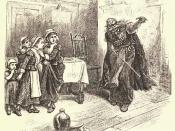Linder
From June through September of 1692, nineteen men and women, all having been convicted of witchcraft, were carted to Gallows Hill, a barren slope near Salem Village, for hanging. Another man of over eighty years was pressed to death under heavy stones for refusing to submit to a trial on witchcraft charges. Hundreds of others faced accusations of witchcraft. Dozens languished in jail for months without trials. Then, almost as soon as it had begun, the hysteria that swept through Puritan Massachusetts ended.
Why did this travesty of justice occur? Why did it occur in Salem? Nothing about this tragedy was inevitable. Only an unfortunate combination of economic conditions, congregational strife, teenage boredom, and personal jealousies can account for the spiraling accusations, trials, and executions that occurred in the spring and summer of 1692.
In 1688, John Putnam, one of the most influential elders of Salem Village, invited Samuel Parris, formerly a marginally successful planter and merchant in Barbados, to preach in the Village church.
A year later, after negotiations over salary, inflation adjustments, and free firewood, Parris accepted the job as Village minister. He moved to Salem Village with his wife Elizabeth, his six-year-old daughter Betty, niece Abagail Williams, and slave Tituba, a West African native acquired by Parris in Barbados.
The Salem that became the new home of Parris was in the midst of change: a mercantile elite was beginning to develop, prominent people were becoming less willing to assume positions as town leaders, two clans (the Putnams and the Porters) were competing for control of the village and its pulpit, and a debate was raging over how independent Salem Village, tied more to the interior agricultural regions, should be from Salem, a center of sea trade.
Sometime during February of the exceptionally cold...



Sanity
The symptonms of the afflicted girls are now looked back upon as symptoms of hysteria. The extended limb movements and outrageous moods are now normal in psych hospitals around the world. You might want to include this along with your essay, for obviously, it was indeed a conspiracy.
5 out of 5 people found this comment useful.